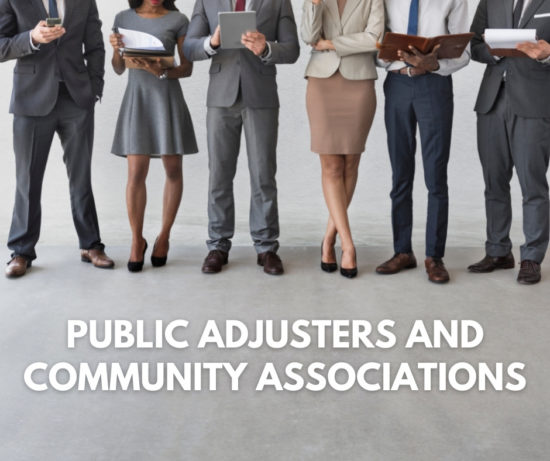
Community associations frequently incur significant and complicated insurance claims. The Colorado Front Range is notorious for intense hailstorms and the resulting roof loss claims. The process to document and submit a claim to the insurer to receive all appropriate insurance proceeds is known as “claim adjustment”. Claim adjustment can be time-consuming and complicated. Many associations turn to public adjusters to assist them in this process. This article provides a brief overview of the functions, benefits, and potential risks when utilizing adjusters.
All property insurance policies contain provisions that require the insured association to present claims for reimbursement to the insurer for its review and consideration. There are three types of individuals known as “adjusters” who can be involved in this process. Their roles differ, and associations need to understand those differences because they can lead to differing outcomes.
The most commonly encountered adjuster is the insurance company’s adjuster. This is the insurance company representative to whom the association submits claim information and documentation to obtain insurance proceeds. The insurance company adjuster is paid by the insurance company. The adjuster represents the interests of the insurance company, and may not necessarily offer top dollar payments to the claiming association. The insurance company adjuster will not charge the association any fee for their work.
An independent adjuster is a person who conducts their own business providing adjustment services for an hourly fee plus incidental costs. Independent adjusters work on a case by case basis with many insurers. Insurance companies frequently use independent adjusters to minimize staffing costs and/or when the insurance company’s office is located far from the loss location. Independent adjusters are also utilized for more complicated insurance claims, which may require particular expertise, site visits, and inspections to determine the value of the insurance claim. The independent adjuster’s fee is paid by the insurance company. An independent adjuster does not have any stake in the outcome and their compensation does not depend on the amount of the insurance claim paid by the insurer to the association.
A public adjuster does not work for the insurance company. Instead, a public adjuster is an independent contractor retained by the association to prepare and present the insurance claim to the insurance company. Public adjusters are paid a contingency fee or commission based upon a percentage of the amount of the claim paid by the insurance company. There is no minimum or required percentage, but one frequently sees 10% as the public adjuster’s fee. Thus, if a public adjuster successfully submits a claim to the insurance company for a $1 million insurance company settlement, the public adjuster’s fee will $100,000 based on a 10% commission.
Public adjusters are licensed by the state of Colorado, but the oversight and licensing regime is not very extensive. Public adjuster clients, including associations, have a right to get out of (rescind) a public adjuster contract if they do so within three days. The statute is C.R.S. §10-2-417.
Community associations frequently employ public adjusters because there is no direct, out-of-pocket expense to the association for using them. But associations need to recognize that there is a financial impact associated with public adjusters. The cost in the example above is the loss of $100,000 of funds which could otherwise be used to rebuild or replace the damaged roof. The association has to fund that gap or forego certain repairs.
The added value a public adjuster can bring to the insurance claim adjustment process is the ability to lobby for the association to obtain additional insurance benefits that the insurance company may not otherwise offer. Public adjusters are generally knowledgeable concerning both insurance policy language and construction practices, topics which may be beyond the familiarity of association managers and Board members. In the Colorado example of a large hail loss claim, they may help associations to obtain better roofing materials plus greater quantities of ancillary materials such as vents, pipe jacks, furnace caps, flashing, etc. Public adjusters can also help present claims for what is known as “law and ordinance” recovery. This is a benefit in some insurance policies which essentially upgrades new roof construction to include requirements arising from building code amendments that were enacted after the original roof was installed.
One recurring situation in public adjuster contracts is one-sided language whereby the association gives up all of its rights to communicate with the insurance company and appoints the public adjuster as the sole representative of the association for negotiating the insurance claim. The insurance company must honor that written commitment, and in those instances, the association is frequently left out of the loop, and the association may not realize that the relationship between the public adjuster and the insurer has become overly adversarial and unproductive.
Another recurring theme is public adjusters who have long-standing, informal relationships with the contractors who end up being referred by the public adjusters to perform the construction work. The public adjuster statute attempts to regulate such tie-in relationships but does so ineffectively. The contractor attempts to perform the work for the cost of the net insurance proceeds available after the public adjuster’s fee. This can lead to construction shortcuts and shoddy construction work.
Association leaders have a duty to look out for the best interests of their owners. Presenting the best possible insurance claim is one of those duties. But the claim adjustment process should not lead to a circumstance where the insurance company becomes antagonistic towards the association. We recommend that all associations review public adjusting contracts with competent legal counsel before signing. We recommend that associations never give up the right to have direct communications with the insurance company. The association’s Board and management should remain vigilant and involved in the adjustment process to make sure it stays on track and results in the best outcomes for the association.
Please feel free to contact an Altitude Community Law attorney if you have any questions at 303.432.9999 or at [email protected].